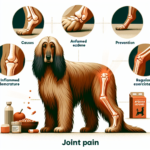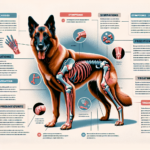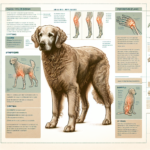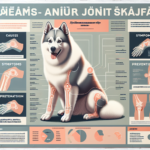Appenzeller Sennenhund Joint Pain: Causes, Symptoms, Prevention, and Treatment

Introduction
The Appenzeller Sennenhund, also known as the Appenzeller Mountain Dog, is one of the four Swiss Sennenhund breeds. Originating from the Appenzell region in Switzerland, this breed was traditionally used for herding cattle, guarding farms, and pulling carts. Known for their agility, intelligence, and robust build, Appenzeller Sennenhunds are medium-sized dogs with a distinctive tricolor coat and a lively, energetic demeanor.
Like many breeds, the Appenzeller Sennenhund is prone to certain health issues, with joint pain being a significant concern. Joint health is crucial for this breed due to their active lifestyle and working heritage. Ensuring the well-being of their joints can help maintain their quality of life and prolong their active years.
Breed-Specific Joint Pain Risks
Genetic Predisposition
The Appenzeller Sennenhund, like many other breeds, has a genetic predisposition to joint-related issues. Common conditions include hip dysplasia, elbow dysplasia, and arthritis. Hip dysplasia is a malformation of the hip joint that can lead to arthritis and pain, while elbow dysplasia involves abnormal development of the elbow joint. Both conditions can significantly impact the dog’s mobility and quality of life.
Age-Related Risks
As Appenzeller Sennenhunds age, the risk of developing joint pain increases. Typically, signs of joint issues may start to appear in middle age, around 5-7 years old. However, some dogs may show symptoms earlier, especially if they have a genetic predisposition or have experienced joint stress from high activity levels.
Activity Level and Joint Stress
The Appenzeller Sennenhund is an active and energetic breed, often involved in activities such as herding, agility, and other dog sports. While regular exercise is essential for their overall health, excessive or high-impact activities can put stress on their joints, potentially leading to joint pain and other related issues.
Common Symptoms of Joint Pain in Appenzeller Sennenhund
General Symptoms
Owners should be vigilant for common symptoms of joint pain, which include:
- Limping or favoring one leg
- Stiffness, especially after rest
- Reluctance to climb stairs or jump
- Decreased activity or playfulness
- Swelling around the joints
- Whining or showing signs of discomfort when touched
Breed-Specific Symptoms
In Appenzeller Sennenhunds, symptoms may be more pronounced due to their active nature. Owners might notice a sudden decrease in their dog’s willingness to participate in activities they once enjoyed, such as herding or agility exercises. Additionally, the breed’s robust build may mask early symptoms, making it crucial for owners to pay close attention to subtle changes in behavior.
When to Consult a Vet
If any of the above symptoms are observed, it is essential to consult a veterinarian promptly. Early diagnosis and intervention can significantly improve the prognosis and quality of life for dogs suffering from joint pain.
Preventive Measures for Joint Health
Exercise Recommendations
Regular, moderate exercise is vital for maintaining joint health in Appenzeller Sennenhunds. Activities such as walking, swimming, and controlled play can help keep their joints flexible and muscles strong without causing excessive stress. Avoid high-impact activities like jumping or running on hard surfaces, especially for extended periods.
Dietary Suggestions
A balanced diet rich in essential nutrients can support joint health. Consider incorporating foods or supplements that contain:
- Glucosamine and Chondroitin: These compounds help maintain cartilage health and reduce inflammation.
- Omega-3 Fatty Acids: Found in fish oil, these fatty acids have anti-inflammatory properties that can benefit joint health.
- Antioxidants: Vitamins C and E can help reduce oxidative stress and support overall joint health.
Weight Management
Maintaining a healthy weight is crucial for reducing joint stress. Excess weight can exacerbate joint pain and lead to further complications. Regularly monitor your dog’s weight and adjust their diet and exercise routine as needed to keep them within a healthy weight range.
Early Screening and Monitoring
Regular veterinary check-ups are essential for early detection of joint issues. Screening tests such as X-rays or joint fluid analysis can help identify problems before they become severe. Early intervention can significantly improve outcomes and help manage joint health effectively.
Treatment Options for Joint Pain
Non-Surgical Treatments
Non-surgical treatments for joint pain in Appenzeller Sennenhunds include:
- Medications: Non-steroidal anti-inflammatory drugs (NSAIDs) can help reduce pain and inflammation. Always consult a veterinarian before administering any medication.
- Physical Therapy: Exercises and therapies designed to improve joint mobility and strength can be beneficial. Hydrotherapy, in particular, is effective for reducing joint stress while providing a good workout.
- Lifestyle Adjustments: Modifying the dog’s activity level and providing a comfortable living environment can help manage pain and improve quality of life.
Surgical Options
In severe cases, surgical intervention may be necessary. Common surgical options include:
- Hip Replacement: This procedure involves replacing the damaged hip joint with an artificial one, significantly improving mobility and reducing pain.
- Arthroscopy: A minimally invasive procedure used to diagnose and treat joint issues.
- Joint Fusion: In cases of severe arthritis, fusing the joint can provide pain relief by eliminating movement in the affected joint.
Alternative Therapies
Alternative therapies can complement traditional treatments and provide additional relief. These include:
- Acupuncture: This ancient practice can help reduce pain and inflammation by stimulating specific points on the body.
- Hydrotherapy: Water-based exercises can improve joint mobility and strength without putting stress on the joints.
- Massage: Regular massage can help reduce muscle tension and improve circulation, benefiting overall joint health.
Lifestyle and Management Tips
Daily Care Routine
A sample daily care routine for managing joint pain in Appenzeller Sennenhunds might include:
- Morning: Gentle walk or swim to loosen joints and muscles.
- Midday: Administer any prescribed medications or supplements.
- Afternoon: Short play session with low-impact toys or activities.
- Evening: Another gentle walk or massage session to relax muscles.
Modifying the Home Environment
Making the home more comfortable for a dog with joint pain can significantly improve their quality of life. Consider the following modifications:
- Install ramps to help them navigate stairs or get onto furniture.
- Provide orthopedic beds to support their joints while resting.
- Ensure food and water bowls are at a comfortable height to reduce strain.
Long-Term Management
Long-term management strategies include regular veterinary check-ups, maintaining a consistent exercise routine, and monitoring their diet and weight. Keeping a close eye on their behavior and adjusting their care as needed can help manage joint pain effectively.
FAQs About Appenzeller Sennenhund and Joint Pain
What are the early signs of joint pain in Appenzeller Sennenhunds?
Early signs include limping, stiffness, reluctance to move, and decreased activity levels. If you notice any of these symptoms, consult your veterinarian promptly.
Can joint pain in Appenzeller Sennenhunds be prevented?
While genetic predispositions cannot be entirely prevented, maintaining a healthy weight, providing a balanced diet, and ensuring regular, moderate exercise can help reduce the risk of joint pain.
Are there specific exercises that are better for Appenzeller Sennenhunds with joint pain?
Low-impact exercises such as swimming and gentle walks are ideal for dogs with joint pain. Avoid high-impact activities that can exacerbate the condition.
What dietary supplements can help with joint health in Appenzeller Sennenhunds?
Supplements containing glucosamine, chondroitin, and omega-3 fatty acids can support joint health. Always consult your veterinarian before adding any supplements to your dog’s diet.
When should I consider surgery for my Appenzeller Sennenhund’s joint pain?
Surgery should be considered when non-surgical treatments are no longer effective, and the dog’s quality of life is significantly impacted. Consult your veterinarian to discuss the best options for your dog.
Conclusion
Joint pain is a significant concern for Appenzeller Sennenhunds, given their active lifestyle and genetic predispositions. By understanding the causes, symptoms, preventive measures, and treatment options, owners can take proactive steps to ensure their dog’s joint health. Regular veterinary check-ups, a balanced diet, appropriate exercise, and a comfortable living environment are crucial for managing and alleviating joint pain. By staying vigilant and informed, you can help your Appenzeller Sennenhund lead a happy, active, and pain-free life.




